Separation anxiety is a particularly frustrating problem for pet parents, and it is surely even more taxing for our furry little friends.
Arguments about the pack-structure of wolves aside, dogs are inherently social animals. And once many of them bond – whether they do so with humans or other critters – they do not like to be separated. When left alone, these poor pooches often feel extremely anxious, and often act out in destructive and potentially dangerous ways.
Today we’re exploring some of the fundamentals of dog separation anxiety, as well as taking a look at the best dog crates for separation-anxiety prone pooches.
Want to get straight to the crates? See our quick guide to the top picks below:
Best Dog Crates for Separation Anxiety: Quick Picks
- #1 ProSelect Empire Dog Crate [Best Overall Crate for Separation Anxiety]: Featuring 20-guage reinforced steel bars, a removable tray, and casters, this crate will keep your canine contained, and it provides several convenient features for owners.
- #2 Petmate Sky Kennel [Most Affordable Crate for Separation Anxiety]: Lightweight, easy to transport, and suitable for air travel, this crate is a great choice for owners who want to avoid spending a fortune on a good crate.
- #3 Impact High Anxiety Crate [Most Secure Crate for Separation Anxiety]: If your doggo could bust out of Fort Knox, this supremely secure crate with high-quality latches and military-grade handles is the perfect choice. [Use code K9OFMINE to get a 15% discount]
This article is pretty lengthy, which is why we’ve broken it down into linkable sections. Feel free to click a category in our table of contents below to jump ahead!
What to Look For in a Crate for Anxious Dogs
While crates vary in a number of ways, including design, size and materials, ones well-suited for anxious dogs all share a number of important features.
- Cave-like crates are more comforting than cage-like crates are. Your dog still needs plenty of ventilation, but generally speaking, the darker and more secluded the crate, the better. Unfortunetly, these ultra-secure canine containers won’t be the coolest looking dog crates around, but they’ll keep your pooch safe.
- Bigger is not always better. While you never want to stuff your poor pooch in an inappropriately small kennel, very large kennels fail to provide the security that smaller quarters do, leaving nervous pups feeling exposed. When choosing a crate, be sure to measure you pup’s length and height. Select a crate that allows your dog to stand up, lie down, and turn around — but don’t pick one much larger than that.
- Crates for anxious dogs must not have places that can be chewed. As mentioned earlier, dogs wrecked with separation anxiety are apt to chew through anything within reach, so be sure to select a kennel that can withstand your pup’s most destructive efforts.
- Crates for severely anxious dogs must be 100% secure. If you must leave your dog alone for a long period of time, you must use a bomb-proof crate that you are positive will contain your four-footer. Soft-sided kennels may be suitable for mildly anxious dogs, but they aren’t appropriate for your neurotic, 90-pound Newfoundland!
An extra-secure dog crate can be helpful for keeping your anxious dog safe and out of harm’s way, but it’s essential that you don’t just leave it at that. You need to help your dog relax and explore separation anxiety behavior modification plans as well as canine anxiety medication if the anxiety is severe.
Separation anxiety is a panic disorder, and while you may not need to worry about your dog destroying the couch while you’re out, your dog is absolutely out of his mind with terror when you are away, regardless of whether he is crated or not.
To be a good canine caretaker, it’s important to address your dog’s mental state too!
The Seven Best Crates for Anxious Dogs
The following seven crates may help you comfort your anxious dog and make her feel better while you are not home. However, you must be sure to select a suitable crate for your circumstances.
This means considering the crate’s size, your dog’s size, and the anxiety level of your pooch before making a selection.
1. Impact High Anxiety Crate
About: Impact’s High Anxiety Crate secures your dog using welded aluminum and military-grade hardware while keeping him cool and comfortable with ventilation designed for optimum airflow. The crate ships fully assembled, too, saving time.
This is a sponsored placement, in which an advertiser pays a fee to be featured in this article. Learn more
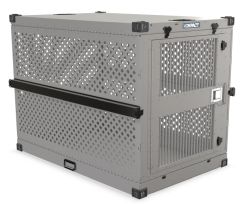
Impact High Anxiety Crate
Perhaps the most secure crate on the market, this aluminum crate features capped corners for stacking and a paddle-slam latch.
Features:
- Has four latches for added security
- Made with 99% recycled materials
- Available in 6 sizes, ranging from 30 to 48 inches long
- Made in the USA
- Get 15% off with code K9OFMINE
Pros
- Durable design and locking system make it escape proof
- Backed by a 10-year dog damage warranty
- Comes with built-in corners to allow stacking
- Paddle-slam latch is easy to open and close
- Financing is available
Cons
- These are expensive crates
- Heavy and a bit hard to move around
I had the chance to test Impact’s High Anxiety Crate with my puppers (including one who has separation anxiety).
TL;DR: I LOVE this crate.
Learn more (and see a pic of one of my dogs on the kitchen counter) here: Impact High Anxiety Crate Review
2. ProSelect Empire Dog Cage
About: The ProSelect Empire Dog Cage is one of the strongest crates on the market and it is made to keep even the most anxious or aggressive dogs safely contained.
This is a sponsored placement, in which an advertiser pays a fee to be featured in this article. Learn more
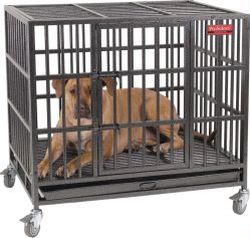
ProSelect Empire Dog Cage
Built like a tank and equipped with casters, a removable tray, and other “extras,” this is a great option for escape-minded dogs.
Features:
- Includes a removable steel tray and four locking casters
- Rust-resistant
- High-grade hammertone finish
- 20-guage, reinforced steel bars
Pros
- Super strong steel bars prevent escapes
- Removable steel tray makes dealing with accidents easy
- Casters make it easy to move
- Secure, yet easy to operate latches
Cons
- Very pricey
- Not available in sizes large enough for really big dogs
3. Petmate Sky Kennel
About: The Petmate Sky Kennel is a no-frills, high-quality kennel that will keep your pup safe and comfortable while you go about your day. Although the kennel is marketed to owners looking for an airplane-friendly kennel, it will also work to keep your separation-anxiety-ridden dog out of trouble while you are at work.
This is a sponsored placement, in which an advertiser pays a fee to be featured in this article. Learn more
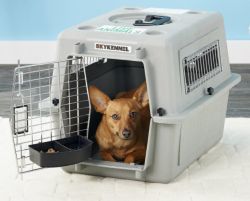
Petmate Sky Kennel
Lightweight, portable, and suitable for air travel, this plastic-sided crate is great for dogs with separation anxiety.
Features:
- Ample ventilation will keep your dog comfortable
- Meets most airline requirements
- Made in the USA
- Made from 25% recycled materials
- Comes complete with food and water cups
Pros
- Crate is dark and secure feeling for dogs
- 4-way, vault-style latches provide security
- Suitable for most airlines
- Easy to disassemble for storage
Cons
- Not as secure as some of the other options discussed here
4. Gunner G1 Kennel
About: Gunner’s G1 Kennel is built tough — so tough it has a 5-star crash rating from the Center for Pet Safety. Featuring an escape-proof, reversible door with a three-part locking system, it’ll keep your anxious pupper safe and secure.
This is a sponsored placement, in which an advertiser pays a fee to be featured in this article. Learn more
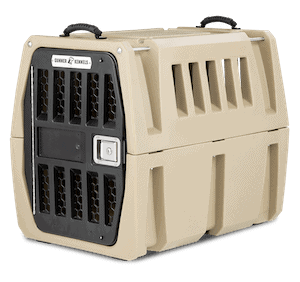
Gunner G1 Kennel
Double-walled, rotomolded kennel that’s strong enough to earn a 5-star crash rating and backed by a lifetime warranty.
Features:
- All-weather construction
- Offered in 3 colors: Tan, Gunmetal, and Mossy Oak
- Available in 4 sizes
- Removable drain plug for cleaning convenience
- Made in the USA
Pros
- Great for powerful pups with separation anxiety
- Escape-proof design to keep your canine contained
- 5-star crash-test rating makes it great for traveling and home use
- Company’s lifetime warranty is a bonus
Cons
- Another pricey option
5. Ruff Land Crate
About: Ruff Land’s Crate makes safely kenneling your worried woofer a breeze. Made of a durable Ruff Flex material, it’s lightweight with less bothersome rattling during travel, whether it’s to the vet or out to the field while hunting.
This is a sponsored placement, in which an advertiser pays a fee to be featured in this article. Learn more
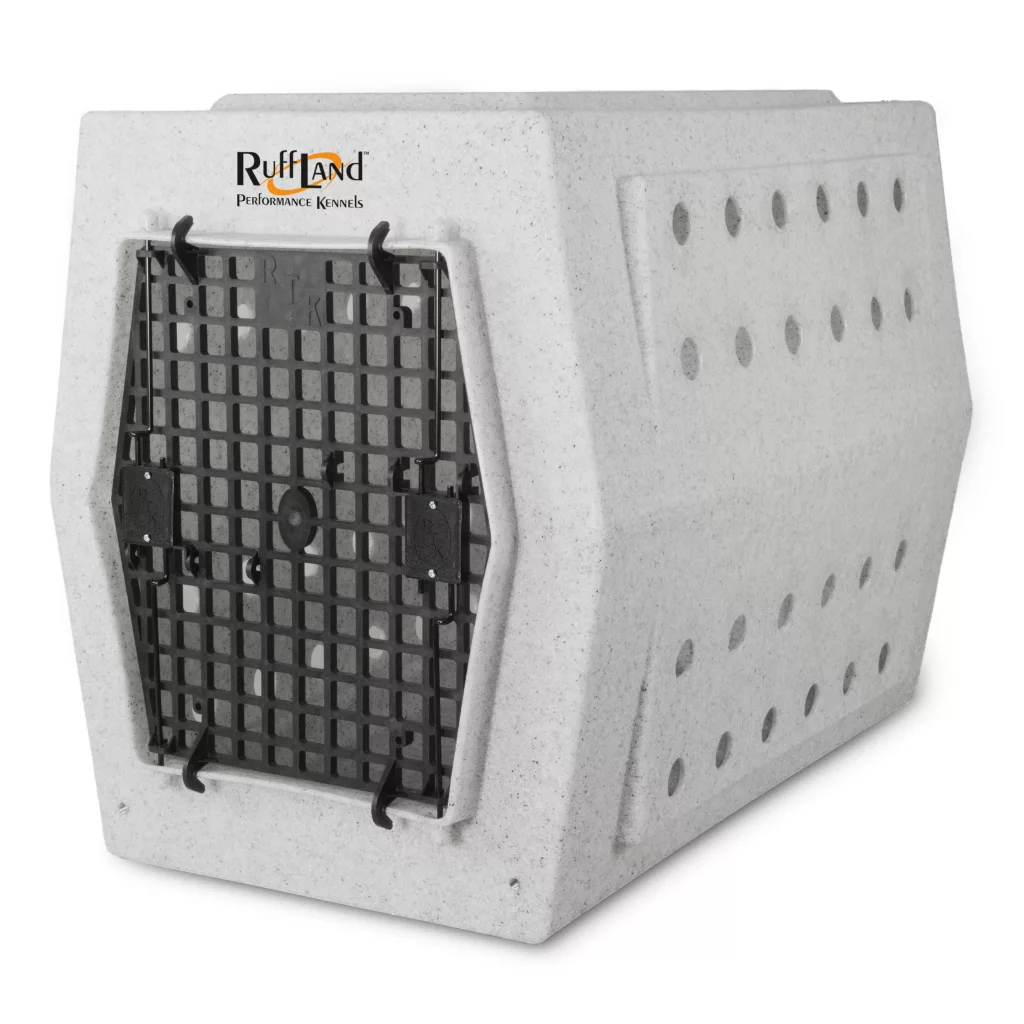
Ruff Land Crate
One-piece molded body makes this crate strong and easy to clean, and it’s available in several different versions to suit your needs.
Features:
- Crate is designed to absorb impacts
- Recessed floor area will keep your pupper dry in the case of an accident
- Features a no-bite door pattern for your pup’s safety
- Options galore: offered in 4 colors, 7 sizes, and 5 door styles
- Made in the USA
Pros
- More affordably priced than many other separation anxiety crates
- Sold directly by the manufacturer
- Multiple door styles provide great flexibility
- No-bite door will help keep your dog safer
Cons
- We wish it had a floor drain
6. Lucky Duck Lucky Kennel
About: The Lucky Kennel’s 5-star crash rating from the Center for Pet Safety brings peace of mind when traveling with your nervous pup. Its lightweight design features sturdy handles for easy transport from point A to B or moving around the house while cleaning.
This is a sponsored placement, in which an advertiser pays a fee to be featured in this article. Learn more
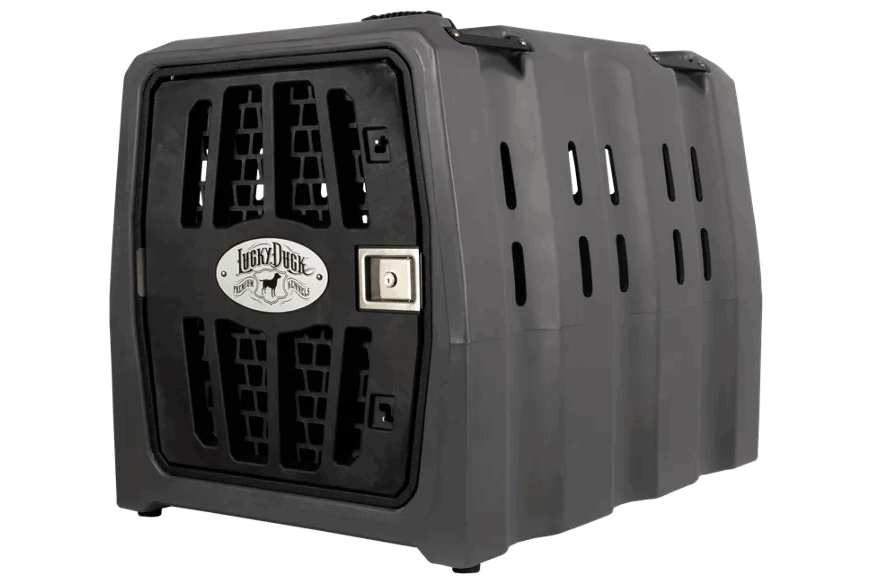
Lucky Duck Lucky Kennel
This roto-molded crate features a one-piece body, and a reversible door and latch you can open or close with only one hand.
Features:
- Door includes corner locking pins and a paddle latch for added security
- Features reversible doors that can open in either direction
- Gripped bottom and tie-down points prevent slippage, even in truck beds
- Side channels and floor drains allow easier cleanup
- Made in the USA
Pros
- Very easy to adjust to suit the space
- Recessed channels and floor drains make cleanup a snap
- Perfect for pupper transportation
- Backed by the manufacturer’s lifetime warranty
Cons
- Dark coloring can get hot if used outside
- Height is a touch short for leggier dogs
7. Carlson Extra Tall Gate
About: Some anxious pups do better when secured in a safe area rather than kenneled, making the Carlson Extra Tall Gate a game-changer. With its see-through barred design, the gate lets your dog still see between rooms and feel included instead of shut away.
This is a sponsored placement, in which an advertiser pays a fee to be featured in this article. Learn more
Features:
- The 28-inch height and 41- to 70-inch width work well in most doorways
- Suitable for small and medium-sized breeds
- Freestanding with no need for tools or wall-damaging drilling
- Made of New Zealand pine
Pros
- Allows your dog to move freely in a designated space
- Takes up far less room than a crate
- Can be taken with you while traveling
- Can be used to create a safe area for multiple dogs
Cons
- Acrobatic pooches may scale the fence
- Not the best pick for large dogs or heavy-duty chewers
Symptoms of Separation Anxiety in Dogs
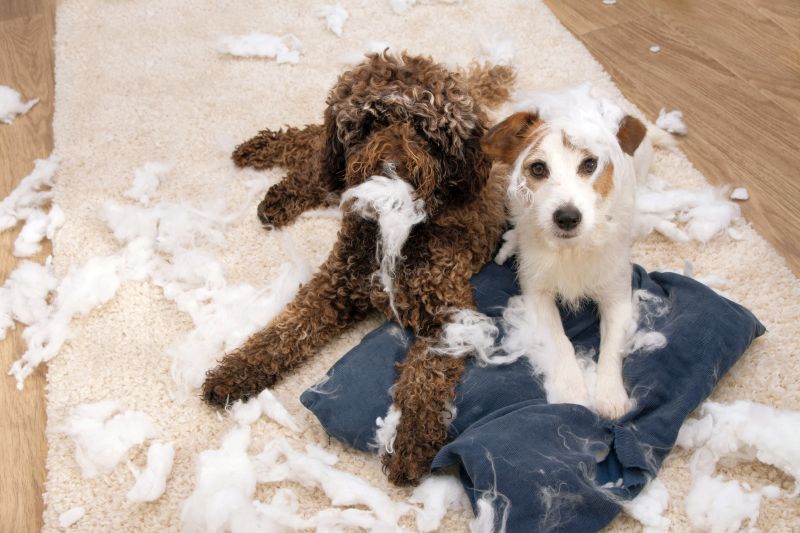
Many dogs get into occasional mischief when left alone in the home.
They may get into the garbage to root out something delicious or sleep on a bed that’s normally off-limits. But most dogs behave themselves reasonably well when left alone, and they don’t cause too much damage.
That said, dogs suffering from separation anxiety are a different matter.
These dogs struggle mightily when alone – even if their person is only away for 10 or 15 minutes. Some of the most common ways dogs express their anxiety (and try to cope with it) include:
- Destructive Chewing – Dogs interact with the world by using their mouths, so when they feel scared or upset, chewing on something can make them feel a little better. Unfortunately, they often like to chew on something that smells like you, and they can destroy treasured belongings in the blink of an eye.
- Excessive Pacing – Nervous energy can make anxious people pace back and forth, and dogs are no different. Nervous pups may pace randomly about the house, or they may walk back and forth in a line, retracing their steps over-and-over.
- Panicking Before You Leave – Perceptive dogs that do not like to be left alone often notice the small clues that indicate your imminent departure. Accordingly, you may notice your dog frantically walking around the house, leaning up against you and shadowing your movements, whenever you grab your keys or put on your shoes.
- Constantly Vocalizing – If you frequently return home to grumpy neighbors complaining about your dogs hootin’ and hollerin’, your dog may be suffering from separation anxiety. However, you must take your dog’s baseline behavior into account before assuming your dog is suffering from anxiety – some dogs are just vocal.
- Going to the Bathroom Indoors – Accidents happen, even among the best-trained and relaxed pups, but if your otherwise-housebroken dog is constantly peeing or pooping indoors on the carpet whenever you leave, she is probably troubled by your absence.
If you notice one or more of these issues with your pooch, she may be suffering from separation anxiety. And this means that — in addition to consulting with a canine behaviorist — you should consider picking up a crate that’ll keep her safe and secure whenever you have to leave.
What Causes Separation Anxiety in Dogs?
Separation anxiety is a relatively well-defined affliction, but it may stem from a wide variety of causes.
Some of the most common causes of the problem (as well as things that are correlated with separation anxiety) include:
- People-pleasing breeds that bond tightly with their owners are some of the dogs most likely to suffer from separation anxiety. By contrast, other breeds barely realize that you’ve left the house, and remain calm whether you are home or not. You can see lists of both types of breeds below.
- Traumatic experiences frequently cause dogs to suffer from separation anxiety. Perhaps not surprisingly, shelter and rescue dogs are among the most common pups to become fearful when their family members leave.
- Major life changes, such as moving or familial changes, can often elicit symptoms of anxiety. The more extreme the change, the more likely your dog is to suffer for an extended period of time.
Dog Breeds Prone to Separation Anxiety
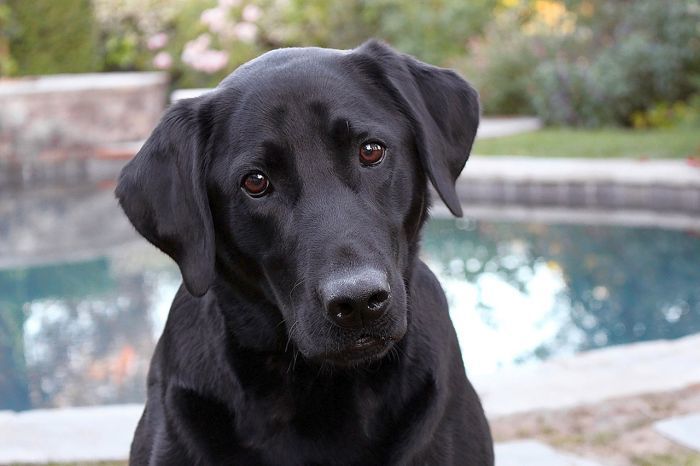
Any dog can suffer from separation anxiety, but some are much more likely to need to be by their parent’s side than others are.
Some of the breeds that most commonly grow anxious at your absence include:
- Labrador retrievers
- Poodles
- Golden retrievers
- Rottweilers
- Cocker spaniels
- Dobermans
- Border collies
- Bichon frises
As discussed above, breeds that are known to be people pleasers and bond very closely to their humans, often suffer from separation anxiety. For them, time away from their owners is simply misery.
By contrast, these breeds tend to be more independent and aren’t often troubled by a bit of alone time:
- English bulldogs
- Chow Chows
- Basset hounds
- Greyhounds
- Whippets
- Shiba Inus
- Shar peis
While these breed tendencies are fairly consistent, it is important to treat your dog as the individual she is. If your dog feels nervous when you leave, then it doesn’t matter whether she is a Chow Chow or a Rottweiler.
Besides, your dog has no idea what breed she is — she simply feels what she feels!
7 Solutions to Separation Anxiety: Helping Your Dog Cope
Like some other behavioral problems, separation anxiety can be a tough nut to crack. There is no one-size-fits-all solution, and you may have to experiment with several different strategies before you find one that works.
We have an entire Separation Anxiety Guide & Training Plan available that you may want to read through. However, some of the most commonly implemented solutions include the following:
1. Provide Your Dog With More Exercise
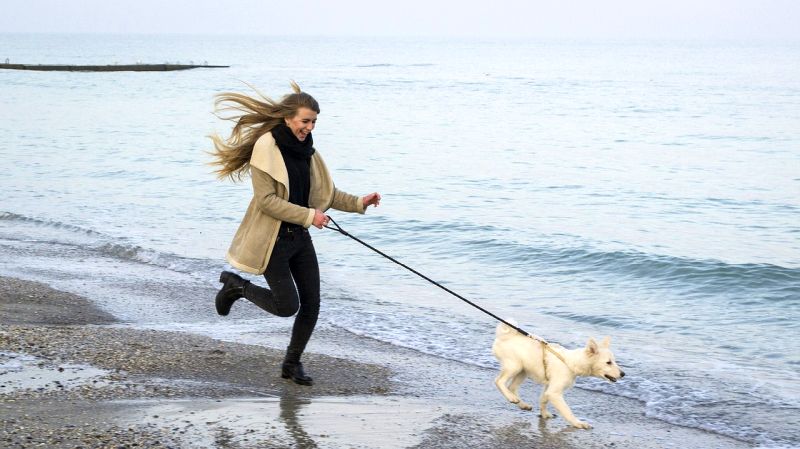
Almost every behavioral problem imaginable can be at least partially remedied by providing your dog with more exercise.
Not only do dogs benefit from the endorphins and general fun experienced during some tennis-ball time, it wears them out, making them more likely to sleep while you are away. However, keep in mind that separation anxiety is a panic disorder, so exercise will only help so much and most certainly won’t eliminate the issue on its own.
2. Don’t Make a Big Deal of Your Coming and Going

We humans have the habit of comforting our dogs before we leave. Human children can be reassured with words promising your return, but these kind intentions can actually set your pup back.
The attention shown to your dog when you come or leave is actually rewarding your dog’s nervous behavior, feeding into his stress cycle.
When puppies cry for our attention, we naturally want to run over and comfort them. However, dogs need to learn how to be without your company in order to grow into confident, secure animals.
When you leave the home, don’t say anything to your dog. Practice the same habit when you return. Don’t shout “I’m finally home, did you miss me?” Instead, walk past your dog and, if she’s waiting politely, you can then go back and let her out.
However, if she’s banging around in the crate and generally going nuts, wait until she is calm. Don’t reinforce her crazed behavior.
3. Desensitize Your Dog to Exit Cues
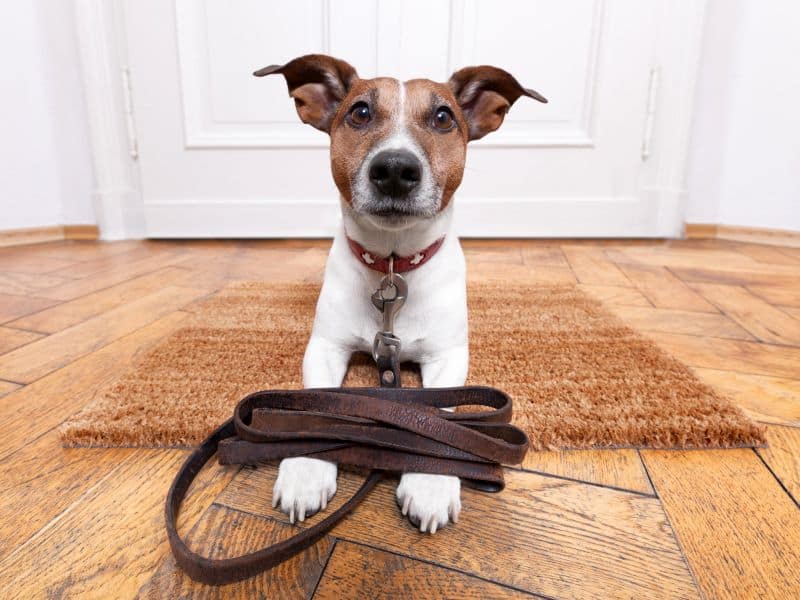
Dogs tend to be very aware of your physical movements and behavioral signals that indicate you’ll soon be departing. You may not be aware of your departure routine, but your dog certainly knows it well!
Instead of grabbing your jacket and jangling your keys as you head out the door, mix up your routine to prevent setting your dog off into a state of panic. Pick up your jacket and purse for time-to-time for no reason, and place departure items in different spots around the home. Exit out of different doors of the house, and remember not to say anything to your dog when you leave — just go.
Practicing alone time should start as a puppy — you can begin by making your disappearances into a game.
Try practicing leaving your dog’s view by having your pup sit and wait while you leave the room for 30 seconds. Then, increase your absence to one full minute, then two minutes, and so on. Start small and work your pup up to longer periods of absence.
4. Slowly Increase Duration of Time Spent Alone
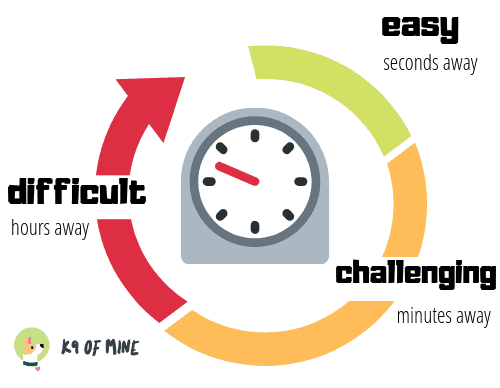
We dig into this with much more detail in our complete Dog Separation Anxiety Guide, but the tried-and-true way to resolve separation anxiety to very slowly acclimate your dog to being alone in stages.
You’ll start just leaving your dog alone for a minute or two while you fetch the mail. Set up a dog camera or monitoring tool to ensure that your dog doesn’t become panicked during this time. If your dog can’t even handle you stepping away for a few minutes, start by just stepping outside for 30 seconds.
Repeat this process a handful of times each day, starting with just minute or two absences. Over the following days, you can graduate to 10 and 20 minute trips away while always monitoring your dog’s stress levels via recordings or remote cameras.
Anytime your dog goes over her threshold and panics with crying or destruction, take a step back and return to leaving for shorter periods of time. Slowly, you’ll build on the amount of time your dog can be comfortably left alone until you can finally be gone for hours at a time without your dog losing it.
The tough thing is, while you work on this process, your dog can’t be left alone for any period that is over her threshold, or a lot of your progress will be lost. Consider employing the help of family, friends, or pet sitters to ensure your dog is never left alone for too long as you work on building up her tolerance.
Your vet may also be able to prescribe dog anxiety medication which, while it won’t eliminate your dog’s anxiety, can usually result in much faster progress and build your dog’s alone-time tolerance more quickly than without the use of drugs.
5. Make The Crate a Fun Place
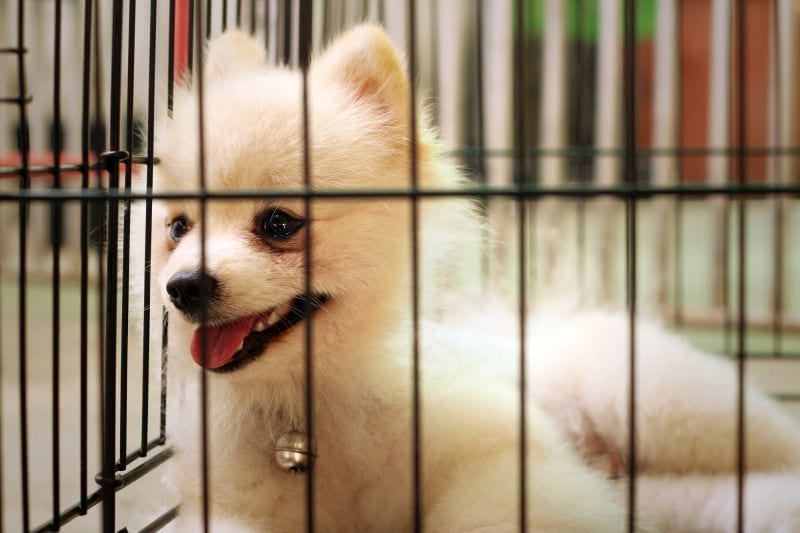
As your dog learns how to be alone, you’ll want to teach your pooch how to accept and even enjoy her crate time (if you crate her when you’re out of the house). Start crate training early to teach your dog how to be alone and how to find comfort in her crate.
Making your dog’s crate a fun and positive place can be done by:
- Feeding her meals in the crate
- Giving her favorite toys or treats during crate time
- Playing crate games with her (see below)
One great method for desensitizing your pet to the crate is by using the crate for a fun game.
- Start by putting treats in the crate and leaving it open, with your dog entering and exiting the crate for treats while the door is left open.
- Repeat the game several times throughout the day.
- Start closing the door with your pup inside while gradually increasing the time increments (start with five seconds, then move up to 15, then 30, and so on). While your dog is in the crate, continue to give her treats to keep the experience positive.
Games like these can go a long way to helping build positive crate experienced for your pooch.
6. Keep Your Dog Occupied
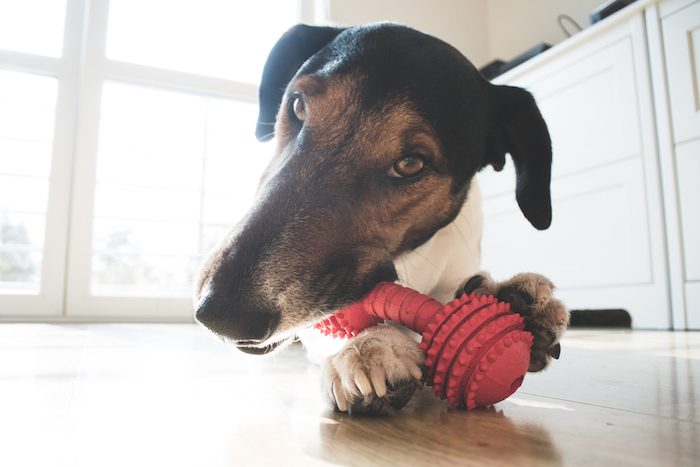
Purchase an especially interesting game or dog puzzle toy to help occupy your pup during alone time. This only works if your dog really loves the toy in question, but assuming she does, it will help distract her while you are away.
Super-cool toys may not completely eliminate her separation anxiety, but they can definitely help. Just don’t be surprised if your dog refuses to engage with her treat-shooting toy when you’re away – it’s not unusual for dogs with extreme separation anxiety to completely ignore food due to their high level of distress.
Many owners also often opt to give their dog a frozen Kong treat when they’re away. Kongs can be stuffed with tasty substances and then frozen, to create a tasty, irresistible item your dog can redirect her energy toward.
Curious about Kongs?
Check out out article on how to make a frozen meal Kong! There are tons of delicious canine-friendly recipes you can choose from!
7. Give Your Dog Comfort Items
Leave familiar and favorite items with your dog when you leave. Although it sounds kind of silly, you may be able to help ease your pet’s worries by leaving a worn T-shirt or pair of socks with her when you must be away for a while. The comfort of her person’s scent may help her feel less lonely.
8. Adopt Another Dog
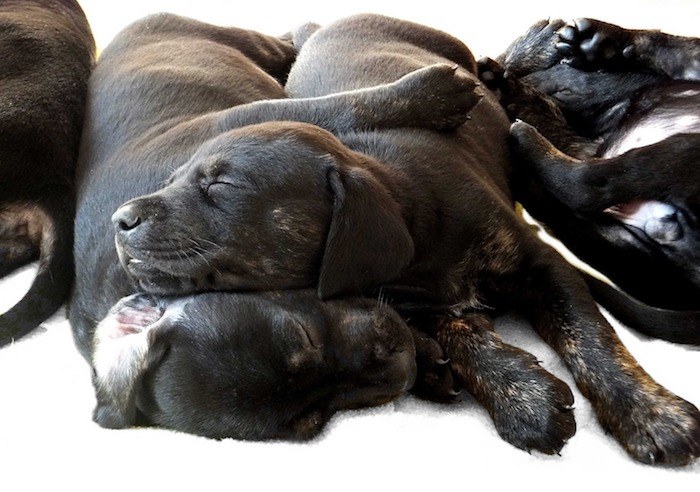
Some dogs will feel better if they have a buddy to hang out with while you are gone.
The key word there is some. For other dogs, a furry friend won’t alleviate their distress at all.
To test out whether a companion could help with your dog’s separation anxiety, consider fostering a shelter dog for a couple of weeks, or watch a friend’s pup while they are away on vacation.
You’ll have to use care to ensure that your dog gets along well with the new addition, and avoid leaving the pair home alone until you are satisfied that they’ll cohabitate peacefully.
Thinking about getting a companion for your pooch? You might want to consider a cat! That’s right – cat-friendly dogs may greatly appreciate a feline sidekick. Just make sure to keep your pooch out of the cat’s litter box!
Naturally this solution won’t be right for everyone — bringing a second dog into your home is a big decision. However, if you’re considering a dual-dog situation anyway, easing separation anxiety is another perk to consider.
9. Try Interactive Monitoring Tools
Another option you can try is providing your pooch with one of the many interactive products that allow you to communicate with her while you are away.
Technology has given dog owners the ability to interact with their pup from afar – some such products even allow you to dispense treats or manipulate a laser pointer. By using these types of devices, you can periodically “check in” with your pet, and calm her fears.
10. Implement a Safe Space Crate
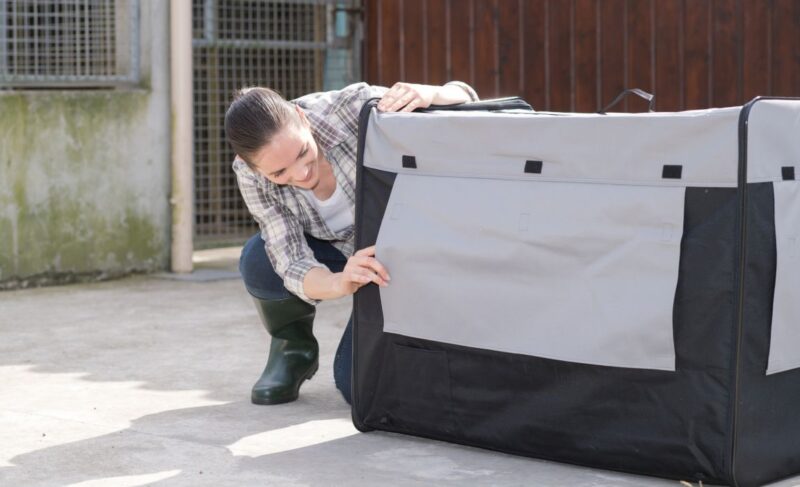
You can also try to utilize a crate to help your dog feel safer while you are gone. Many dogs love to hide in tight, secure little cavities. A well-selected crate can provide this type of “hiding box” for your pup, and keep her out of trouble while you are gone.
Most of the crates discussed above should help in this regard!
11. Take Your Dog Everywhere
One obvious, if challenging, option, is to simply accept that your dog will perpetually live in your shadow and make the appropriate changes to your lifestyle. Of course this isn’t a realistic option for all owners, but it is the only reasonable solution for some anxiety-stricken dogs.
And with remote working at an all-time high, it isn’t so ridiculous to imagine that you could spend the majority of your hours with your pup at home. If you choose to go this route, you’ll need a good travel crate to keep her safe while in unfamiliar locations.
It’s also worth noting that some dogs age out of separation anxiety, although you’ll likely need to power through some turbulent times to reach those more relaxed senior years.
***
All dogs should have a safe place to hang out when they are anxious, and a cozy little crate is perhaps the perfect option.
Consider the crates we’ve outlined here, and try to incorporate one of them into your anxiety-preventing plan.
We’d love to hear success stories from owners with anxious pups! How did you stop your dog’s destructive behavior? Has extra exercise helped keep her calm when you leave? Has one of the heavy-duty crates discussed above worked?
Let us know in the comments below.

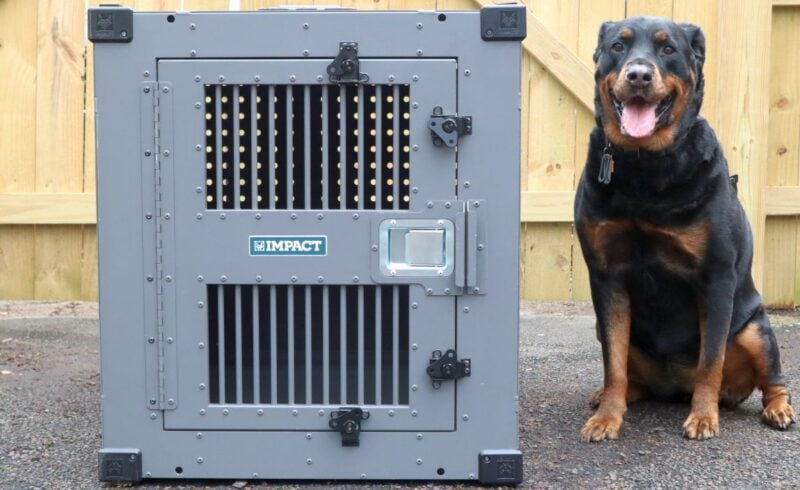


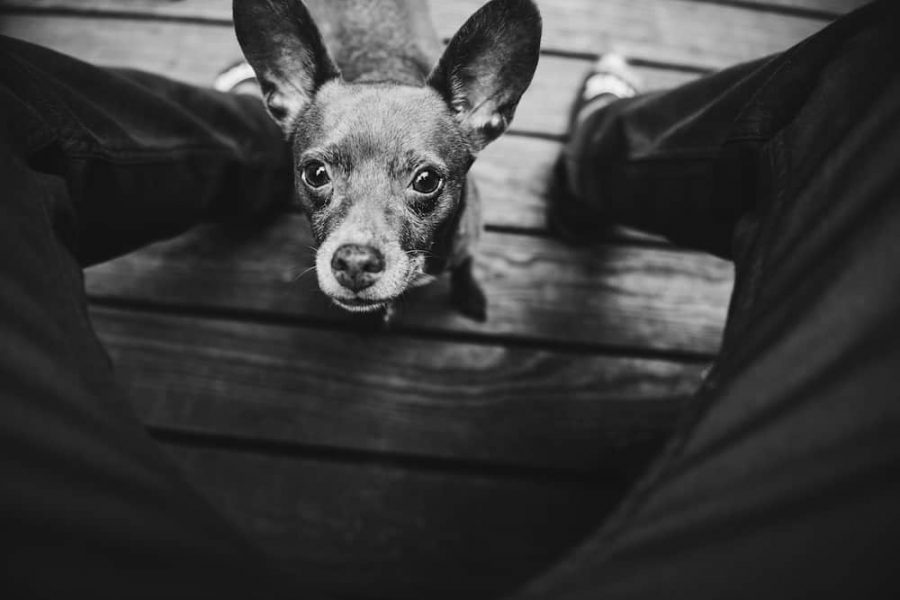


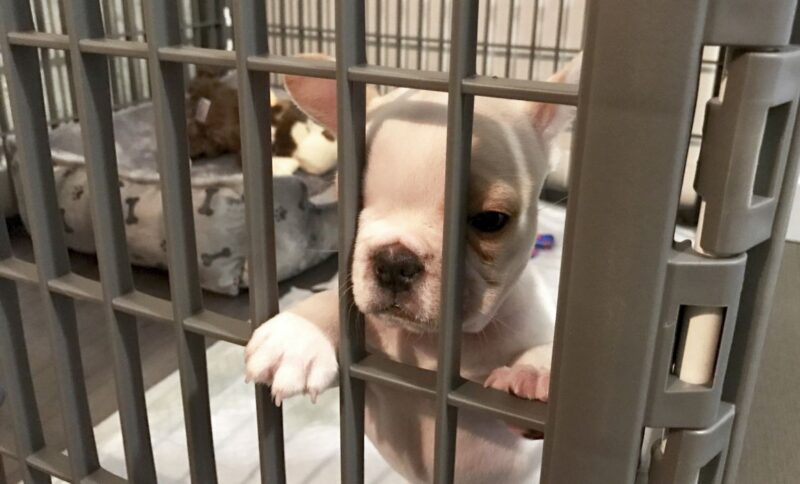
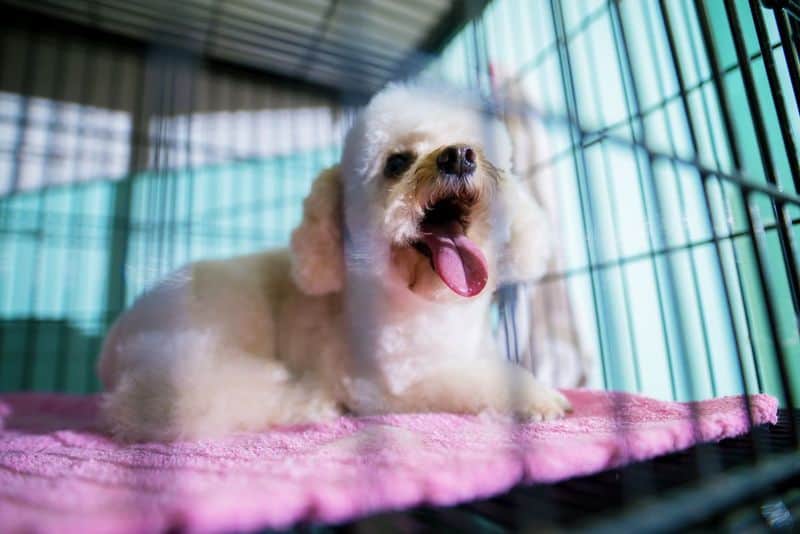
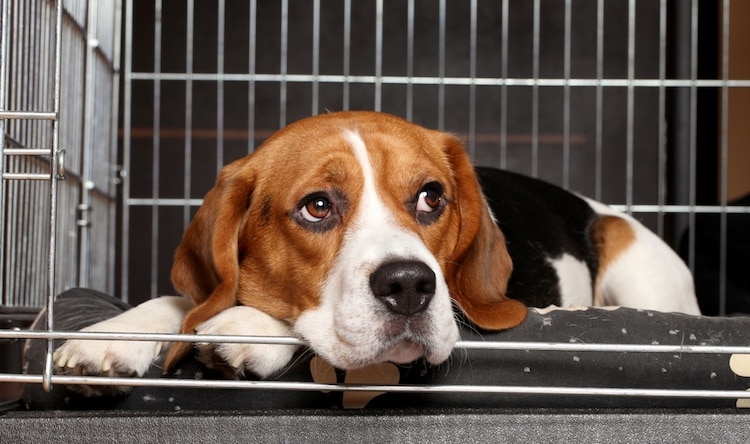
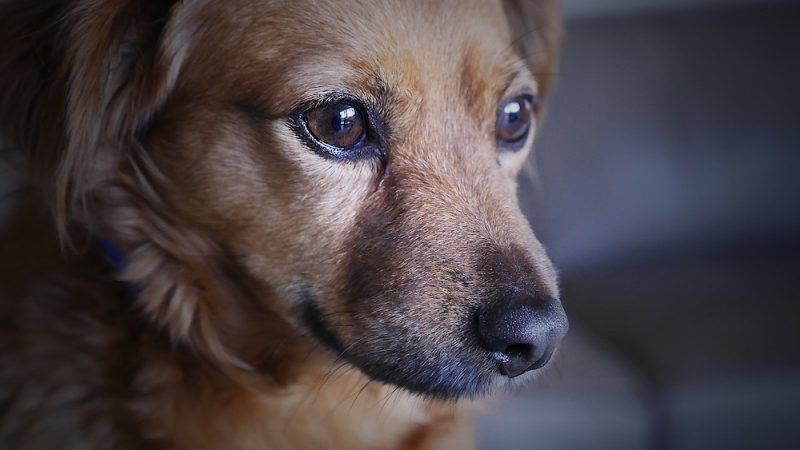


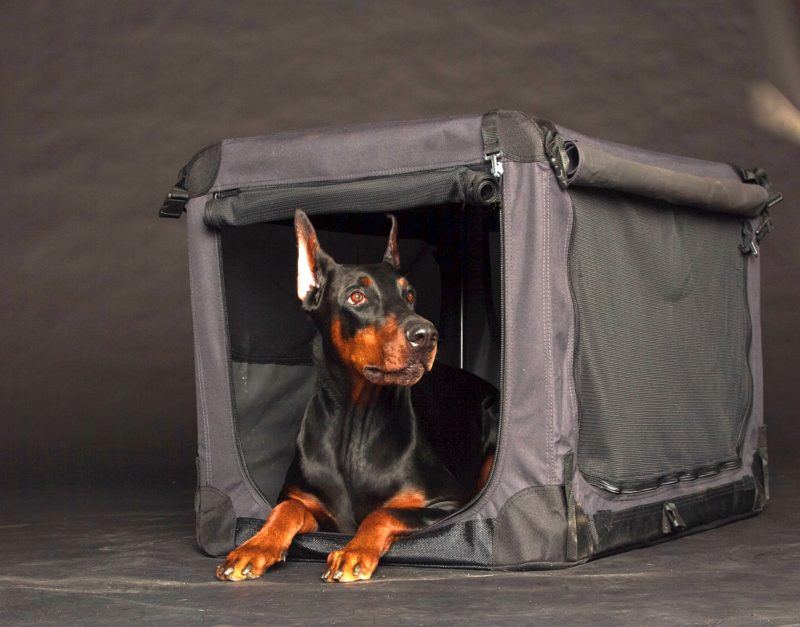

Leave a Comment